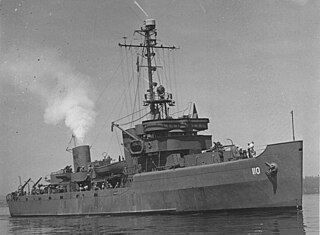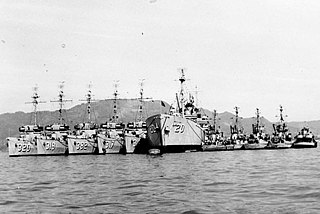
USS Revenge (AM-110) was a World War II-era Auk-class minesweeper in the service of the United States Navy. It was the sixth United States vessel named Revenge.

USS Shelter (AM-301) was an Admirable-class minesweeper built for the United States Navy during World War II. After service in the Pacific during World War II, Shelter was decommissioned in June 1946 and placed in reserve. In January 1964, she was transferred to South Vietnam for service in the Republic of Vietnam Navy as RVNS Chi Linh (HQ-11). She remained in South Vietnamese service until the collapse of that country in 1975. Chi Linh was one of several ships that fled from South Vietnam to the Philippines. She was then commissioned into the Philippine Navy in April 1976 as RPS Datu Tupas (PS-18), named after a chieftain of Cebu. The ship's fate is not reported in secondary sources.

USS Ruddy (AM-380) was an Auk-class minesweeper acquired by the U.S. Navy for the dangerous task of removing mines from minefields laid in the water to prevent ships from passing. She was the only U.S. Navy ship named for the North American ruddy duck.

USS Shoveler (AM-382) was an Auk-class minesweeper acquired by the U.S. Navy for the dangerous task of removing mines from minefields laid in the water to prevent ships from passing.
USS Heed (AM-100) was an Auk-class minesweeper built for the United States Navy during World War II. She earned five battle stars for her World War II service. She was recommissioned during the Korean War. She was placed in reserve in 1954 and remained there until struck from the Naval Vessel Register in 1967.

The third USS Champion (BAM-1/AM-314/MSF-314) was an Auk-class minesweeper of the United States Navy.

USS Staff (AM-114) was an Auk-class minesweeper acquired by the United States Navy for the dangerous task of removing mines from minefields laid in the water to prevent ships from passing.

USS Hornbill was a YMS-1-class minesweeper of the YMS-135 subclass built for the United States Navy during World War II. After World War II, she continued to be in use until the mid-1950s.
USS Superior (AM-311) was a steel-hulled Admirable-class minesweeper built for the U.S. Navy in 1944. Superior participated in the final struggle in the Pacific Ocean against the Empire of Japan during the end of World War II and remained behind, after the war ended, to clear minefields laid during the war.
USS Success (AM-310) was an Admirable-class minesweeper built for the United States Navy during World War II. She was awarded four battle stars for service in the Pacific during World War II. She was decommissioned in July 1946 and placed in reserve. While she remained in reserve, Success was reclassified as MSF-310 in February 1955 but never reactivated. In October 1962, she was sold to the Mexican Navy and renamed ARM DM-08. Although she is reported out of service, her ultimate fate is not reported in secondary sources.
USS Specter (AM-306) was an Admirable-class minesweeper built for the United States Navy during World War II. She was originally ordered, laid down, and launched as USS Spector (AM-306), but was renamed the correctly spelled Specter in March 1944. She was awarded four battle stars for service in the Pacific during World War II. She was decommissioned in 1946 and placed in reserve. While she remained in reserve, Specter was reclassified as MSF-306 in February 1955 but never reactivated. In April 1973, she was sold to the Mexican Navy and renamed ARM DM-04. In 1994 she was renamed ARM General Manuel E. Rincón (C52). She was stricken in July 2001, but her ultimate fate is not reported in secondary sources.
USS Spectacle (AM-305) was a steel-hulled Admirable class minesweeper built for the U.S. Navy during World War II. A trained crew boarded the new vessel, practiced with her minesweeping gear, and then proceeded to the Pacific Ocean to clear mines from Japanese beaches so that Allied forces could invade. While performing this dangerous task of mine clearance, a Japanese plane strafed her, and another deliberately crashed into her. When she returned to the United States, her battle damage was so severe that the U.S. Navy decided to scrap, rather than to repair, her. She was awarded two battle stars.
USS Scurry (AM-304) was a steel-hulled Admirable-class minesweeper constructed for the U.S. Navy during World War II. She was crewed by sailors who were trained in minesweeping, and quickly sent to the Pacific Ocean to clear minefields so that Allied forces could invade Japanese-held beaches. For this dangerous work, often under enemy fire, she was awarded four battle stars.
USS Compel (AM-162) was an Admirable-class minesweeper built for the U.S. Navy during World War II. She was built to clear minefields in offshore waters, and served the Navy in the Pacific Ocean. Compel was awarded one battle star for World War II service.
USS Device (AM-220) was an Admirable-class minesweeper built for the United States Navy during World War II. She was awarded three battle stars for service in the Pacific during World War II. She was decommissioned in August 1946 and placed in reserve. Although she did not see service in the war zone, Device was recommissioned in March 1950 during the Korean War and remained in commission until February 1954, when she was placed in reserve again. While she remained in reserve, Device was reclassified as MSF-220 in February 1955 but never reactivated. In October 1962, she was sold to the Mexican Navy and renamed ARM DM-11. In 1994 she was renamed ARM Cadete Agustín Melgar (C54), spelled Augustín Melgar in some sources. She was stricken in 2000, and scuttled for use as an artificial reef in Bahía de Loreto National Park.
USS Hilarity (AM-241) was an Admirable-class minesweeper built for the United States Navy during World War II. She was awarded two battle stars for service in the Pacific during World War II. She was decommissioned in 1946 and placed in the Atlantic Reserve Fleet. While she remained in reserve, Hilarity was reclassified as MSF-241 in February 1955 but never reactivated. In October 1962, she was sold to the Mexican Navy and renamed ARM DM-02. She was stricken in 1986 and scrapped in August 1988.
USS Implicit (AM-246) was an Admirable-class minesweeper built for the U.S. Navy during World War II. She was built to clear minefields in offshore waters, and served the Navy in the North Atlantic Ocean and then in the Pacific Ocean. She finished the war with two battle stars to her credit.

USS Quest (AM-281) was an Admirable-class minesweeper built for the United States Navy during World War II. She was decommissioned in 1947 after wartime service and transferred to the Philippine Navy in 1948 where she served as presidential yacht RPS Pag-asa (APO-21). In 1955, she was renamed Santa Maria and, later, Mount Samat (TK-21), serving as a patrol corvette of the Miguel Malvar class. She was decommissioned from the Philippine Navy in 1970; beyond that, her fate is not reported in secondary sources.
USS Skirmish (AM-303) was an Admirable-class minesweeper built for the United States Navy during World War II. She received four battle stars during World War II. She was decommissioned in December 1945 and placed in reserve. In February 1955, while still in reserve, her hull number was changed from AM-303 to MSF-303, but she was not reactivated. She was transferred to the Dominican Republic in January 1965 and renamed Separación (BM455). She was employed as a patrol vessel in Dominican Navy service and renamed Prestol Botello in 1976. Her pennant number was changed from BM454 to C454 during a 1995 refit. As of 2007, Prestol Botello remained in active service for the Dominican Navy.

USS Ostrich was a YMS-1-class minesweeper of the YMS-135 subclass built for the United States Navy during World War II. She was the third U.S. Navy ship to be named for the ostrich.







